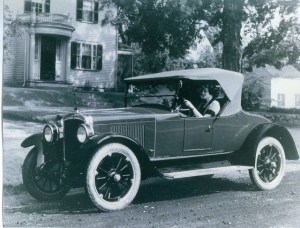After completing his second year of high school, Richard Henry Long (1865 – 1957) already knew what he wanted to do for the rest of his life. By this time, he had begun his career as a businessman in his father’s shoe manufacturing firm in Braintree, MA. At the age of twenty-four, he took over running the company. Long made a lasting impact on the industry as he instituted the use of employee time cards. He explained to his workers that by keeping track of their time (the cost of labor) he could accurately figure out the actual cost of the shoes. Under his leadership, the business grew so much that Long had to find a larger factory building. In 1895, he moved the company to Belchertown in western Massachusetts and renamed it the R. H. Long Shoe Manufacturing Company. The demand for their Traveler and Waldorf shoes was so great that soon Long had to once again find a larger building for the company. In 1902, on a train ride through Framingham, he noticed a building for rent. He got off the train at the next stop and walked back to look at it, and ended up signing a five year lease. With his company now in Framingham, he rented a home only a couple of miles away from his new factory on Newton Place and got to work growing his business even more.

When the Long family grew to five children, R. H. purchased a much larger home, the Nevins Estate, which was located on 325 acres between Farm Pond, Reservoir No. 2, and the railroad. In 1910, he built a five story modern factory building which featured large windows for better lighting and ventilation, a cafeteria that offered good food at reasonable prices, and a first-aid room staffed by nurses on this land. This building, now known as the Bancroft Lofts located at 59 Fountain Street, was renovated in 2018 as an apartment complex.
During World War I, Long decided to change the focus of his business. He retooled his shoe factory to make canvas and leather products which were in high demand for the British and American armies. Business was very good and once again the company needed more factory space, so he bought the Bela Body Co., which built automobile bodies. Just a few months after he bought this business, the war ended and the government cancelled all their orders for the canvas and leather army supplies-so Long now found himself in the automobile business!

Besides being a successful businessman, R. H. Long was also active in Massachusetts politics. He was the Democratic candidate for Lieutenant Governor in 1912, but lost the election. In 1918 and 1919, he again ran for public office, but this time for the governorship. He lost both elections to his Republican opponent, Calvin Coolidge.
Tragedy struck the Long Family in 1920. His wife, Mabel died on July tenth in a plane crash while on a sightseeing flight over the Hampton and Salisbury beach area of New Hampshire. To keep busy, Long threw himself into a new business venture.
In the Bela Body factory on Clark Street in Framingham and in a new factory he built in Worcester, Long began making his own line of cars which he called the Bay State. He set out to make a high quality car with the looks and performance of a luxury car that sold for an affordable price. He made only two models: one with a six cylinder engine and the second with an eight cylinder engine. They were available in different body styles, ranging from a two seater roadster to a seven passenger sedan. During the four years the company was in business, only about four thousand Bay State automobiles were produced.

The end of the Bay State Auto Company did not end R. H. Long’s involvement with automobiles. His next business move was to open a car dealership. In 1927, he began selling Cadillacs out of an old shoe factory building on Waverly Street in South Framingham. Business was so good, that he was soon selling GMC vehicles and Pontiacs alongside the Cadillacs.
In 1927, R. H. Long turned the management of the dealership over to his son Charles who had just graduated from Harvard, but R.H. was far from retirement! He continued to work at the dealership until he was in his eighties. He passed away on April 16, 1957 at the age of ninety-one. His company is still in the business of selling Cadillacs today. It is known as the Long Auto Group and is headquartered in Southborough, Massachusetts.
Bibliography
Berkowitz, Rebecca. “R. H. Long, Automobiles and Historic Framingham.” Framingham Patch, 13 July 2011. https://patch.com/massachusetts/framingham/rh-long-automobiles-and-historic-framingham. Accessed 3 May 2017.
“Cadillac’s Marathon Man.” Cadillac Insider Magazine. May/June 1991. Long Automotive Group, 2017. https://www.longauto.com/cadillac-s-marathon-man. Accessed 14 May 2017.
Cegelis Sylvia. “The “Bay State’ Returns.” The South Middlesex News, 14 June 1975. Long Auto Group 2017. www.longauto.com/the-bay-state-returns. Accessed 14 May 2017.
Long, Charles F. Sr. A Family History: Long, White, Fernald, Bradshaw. Vanguard Communications, 1990.
“The Long Story.” Long Automotive Group, 2017. www.longauto.com/the-long-story. Accessed 7 May 2107.
“Richard H. Long marries his typist.” The New York Times, 19 July 1921. https://www.Ancestry.com/mediauiviewer/tree/1793022/person/556723561/Medi/2b9a58c4-5fae-4fde-9528-901c821a9eb8. Accessed 01 June 2017.
Theobald, Mark. “Bela Body Co.” Coachbuilt, 2004. http://www.coachbuilt.com/bui/b/bela/bela.htm. Accessed 14 May 2017.